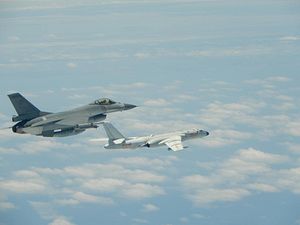China’s new Sukhoi Su-35S (NATO reporting name: Flanker-E) for the first time escorted an undisclosed number of People’s Liberation Air Force (PLAAF) Xian H-6K bombers and support aircraft during a long-range patrol over the Bashi channel and around the island of Taiwan on May 11, the PLAAF said in a statement.
The long-range patrol circling Taiwan included two groups of H-6K bombers from the People’s Liberation Army’s (PLA) Eastern Theater Command and Southern Theater Command with one formation flying clockwise and the other counter-clockwise. The PLAAF described the joint patrol as a “new breakthrough” in its flights “around the island.”
According to the Republic of China’s Air Force Command Headquarters, the PLAAF aircraft flying on a northern route went through the Miyako Strait, located between the Japanese islands of Miyako and Okinawa, and then on through the Bashi Channel, a waterway between the Philippines and the Taiwanese island of Orchid, circling Taiwan, while other PLAAF planes flew in the reverse direction before returning to base.
Next to the Su-35S and H-6Ks, the long-range patrol included J-11 fighter jets, Shaanxi Y-8 electronic countermeasures aircraft, Tupolev Tu-154MD electronic intelligence planes, and KJ-2000 airborne early warning aircraft. In response to the PLAAF drill, the Republic of China Air Force scrambled Lockheed Martin F-16 A/B Fighting Falcons.
According to the Japanese Ministry of Defense (MoD), two unidentified PLAAF fighter jets, four H-6K bombers, one Tu-154MD, and one Y-8 aircraft passed through international airspace between the Japanese islands of Okinawa and Miyako in the East China Sea today. The Japan Air Self Defense Force also scrambled fighter jets in response.
“The air force has the resolve, the confidence, and the ability to safeguard national sovereignty and territorial integrity,” a PLAAF spokesperson said on May 11. The spokesperson also noted that the PLAAF will continue to carry out long-range patrols involving multiple aircraft in accordance with the service’s training schedule.
PLAAF aircraft regularly circle Taiwan. China has lately, however, been stepping up flight operations around the strategically important Miyako Strait — a principal entryway for the People’s Liberation Army Navy (PLAN) into the Pacific Ocean. The PLAAF has also increased its presence in the Bashi Channel, a strategically pivotal waterway connecting the South China Sea with the western Pacific Ocean.
In the event of a conflict with Taiwan or Japan, the Miyako Strait and Bashi Channel would be critical chokepoints, the seizure of which could delay third party intervention (e.g., by the United States) and secure the so-called first island chain. (PLA doctrine reportedly mandates sealing off the Yellow Sea, South China Sea, and East China Sea from U.S. air and naval assets in the event of conflict.)
The sole operational aircraft carrier of the PLAN, the 60,000-ton Liaoning, a retrofitted Soviet-era Admiral Kuznetsov-class multirole aircraft carrier, along with its escort, entered Taiwan’s air defense identification zone and sailed through the Taiwan Strait already twice this year.

































